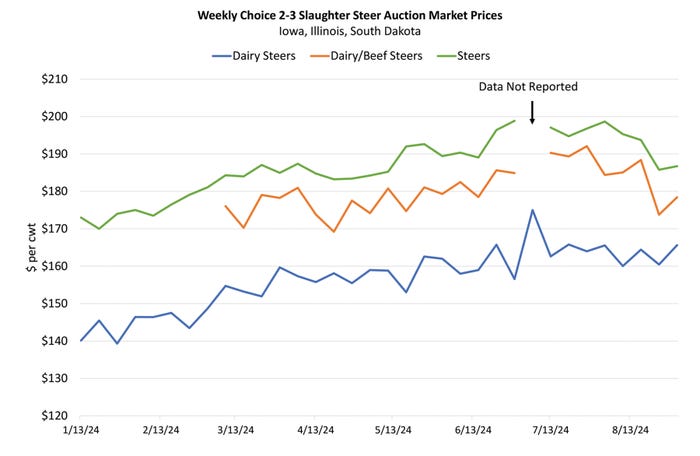More price data on beef-on-dairy crossbreds now available
Posted on September 16, 2024 by Lee Schulz
Source: Farm Progress. The original article is posted here.

The rising share of beef-on-dairy crossbreds in the slaughter mix fuels interest among market participants in knowing price relationships among types of cattle. Specifically:
Are beef-on-dairy crossbred prices closer to dairy-breed or beef-breed cattle prices?
Do price differences vary within the year?
When supply or demand changes, do price differences also change?
You can use data from various USDA Agricultural Marketing Service (AMS) reports to help answer these questions.
Formula prices with discounts applied
The USDA’s Cattle Contracts Library Pilot Program requires packers within the reporting threshold to provide information on contracts they use to buy cattle. AMS aggregates the data on a national level. The focus is on the base price source, base price adjustments, contract specifications, premiums, discounts and volume. A discount is an adjustment, expressed either in dollars per 100 pounds (cwt) or per head, subtracted from the base price.
As of Sept. 4, “beef/dairy cross” discounts on a per-head basis were $18.75 as a simple average. The 25th to 75th percentile range, used in the Cattle Contracts Library to protect confidentiality, were discounts of $20 to $18.75 per head. On a per hundredweight basis, “beef/dairy cross” discounts averaged $2.34 with a range of $3.04 to $1.06. For comparison, the discount for “dairy-type” cattle averaged $32.58 per cwt with a range of $40 to $14.75.
Data collection for slaughter cattle occurs through either auctions or direct trade reporting. Auction data is compiled by market reporters who grade the live cattle. Most slaughter cattle reported through auctions are cows and bulls, although some markets also have steers and heifers. Direct trade reporting of slaughter cattle is collected through livestock mandatory reporting (LMR). Most steers and heifers and some cows and bulls sell through direct trade.
Third category would add insight
AMS does not currently identify beef-on-dairy crossbred cattle separately in LMR purchase data collected from packers. It only offers two categories: beef or dairy. As a result, packers report beef-on-dairy crossbred cattle as either beef or dairy. The prevalence of beef-on-dairy crossbred cattle may merit a third reporting category of dairy/beef. Until that occurs, interested parties need to look to other sources of information.
Fortunately, beginning in March, auction market reports began to include “dairy/beef” information. We combine data from the Iowa Weekly Cattle Auction Summary , South Dakota Weekly Cattle Auction Summary and Illinois Weekly Cattle Auction Summary to get a representative market. Most fed dairy cattle and dairy/beef crosses are purchased by packers through direct trade using forward contracts or formula trade.

(USDA-AMS)
Since March, of the total slaughter cattle receipts in these three weekly auction market reports, 40% have been steers (AMS leaves off the beef-breed descriptor for short-hand), 28% heifers, 22% cows, 4% dairy steers, 3% bulls, 2% dairy/beef steers and 1% dairy/beef heifers. Dairy heifers have accounted for less than 1% of the volume.
The discount for dairy/beef steers compared with steers has averaged $9.51 per cwt so far in 2024. The discount for dairy steers compared with steers has averaged $30.27 per cwt. Comparisons are for the choice quality grade and 2-3 yield grade designation, which is where most of the comparable steer volume is.
Feeder cattle data more limited
Feeder cattle auction market reports also have begun to include “dairy/beef” information. One report is the Superior Livestock Video/Internet Auction . In this report, Iowa is in the North Central reporting region with Colorado, Montana, North Dakota, Nebraska, South Dakota and Wyoming.
For the week ending Aug. 23, under the medium and large 1-2 designation, 35 head of dairy/beef steers averaging 750 pounds for current delivery sold for $240 per cwt. For August-September delivery, 310 head of dairy/beef steers averaging 650 pounds sold for $272 per cwt. Three-hundred head of dairy/beef steers averaging 650 pounds for November delivery sold for $269 per cwt.
South Dakota auctions have reported a few dairy/beef feeder cattle. However, you have to look to the Pennsylvania Weekly Cattle Auction Summary for any appreciable volume. There, dairy/beef steers and dairy/beef heifers each have accounted for 4% of the feeder cattle receipts since March.
For the week ending Aug. 17, medium and large 2 steers averaging 766 pounds brought $221.33 per cwt. The equivalent dairy/beef steers averaging 768 pounds brought $197.46 per cwt. The following week, steers averaging 766 pounds brought $210.35 per cwt and dairy/beef steers averaging 760 pounds brought $205 per cwt.

.jpg?disable=upscale&width=1200&height=630&fit=crop)


